MHW 510 Course: Analyzing Social and Cultural Diversity Paper
VerifiedAdded on 2022/02/15
|10
|2640
|16
Essay
AI Summary
This paper, written for Grand Canyon University's MHW 510 course, delves into the multifaceted nature of social and cultural diversity and its implications for mental health professionals. It explores the impact of race, religion, age, sexual orientation, ethnicity, gender, disability status, and cultural dynamics on professional relationships. The author, drawing from personal experiences and Christian beliefs, discusses personal biases related to the LGBT community and dress codes, and how these biases might impact their work. The paper defines and differentiates between stereotypes, prejudice, discrimination, and racism, providing personal examples of encountering these concepts as an African American. It emphasizes the importance of understanding diverse cultures to build effective therapeutic relationships, referencing the American Counseling Association's guidelines. The author concludes by highlighting the necessity of self-awareness, open-mindedness, and fairness in order to provide effective mental health services to a diverse clientele. This assignment is available on Desklib for students to access and study.
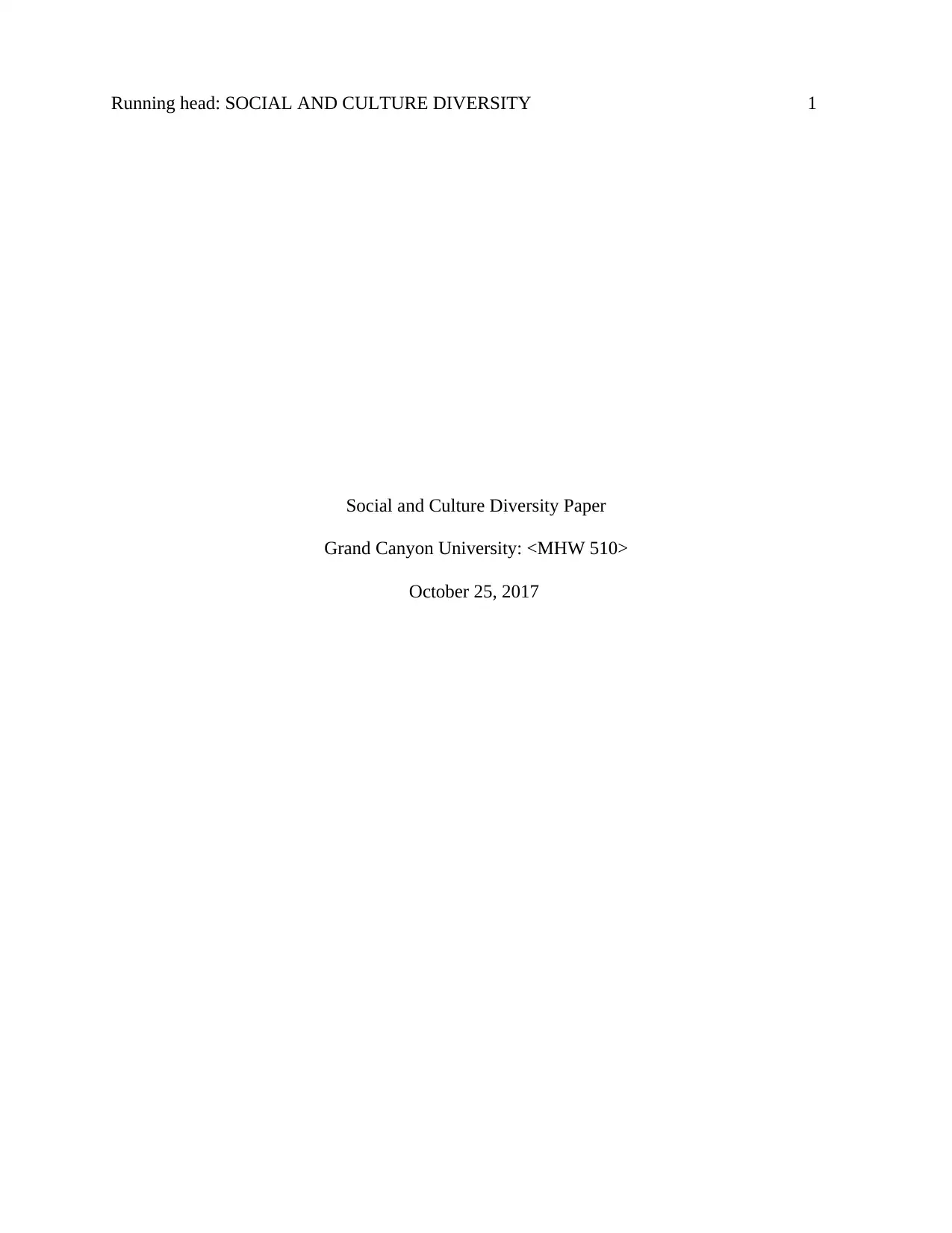
Running head: SOCIAL AND CULTURE DIVERSITY 1
Social and Culture Diversity Paper
Grand Canyon University: <MHW 510>
October 25, 2017
Social and Culture Diversity Paper
Grand Canyon University: <MHW 510>
October 25, 2017
Paraphrase This Document
Need a fresh take? Get an instant paraphrase of this document with our AI Paraphraser
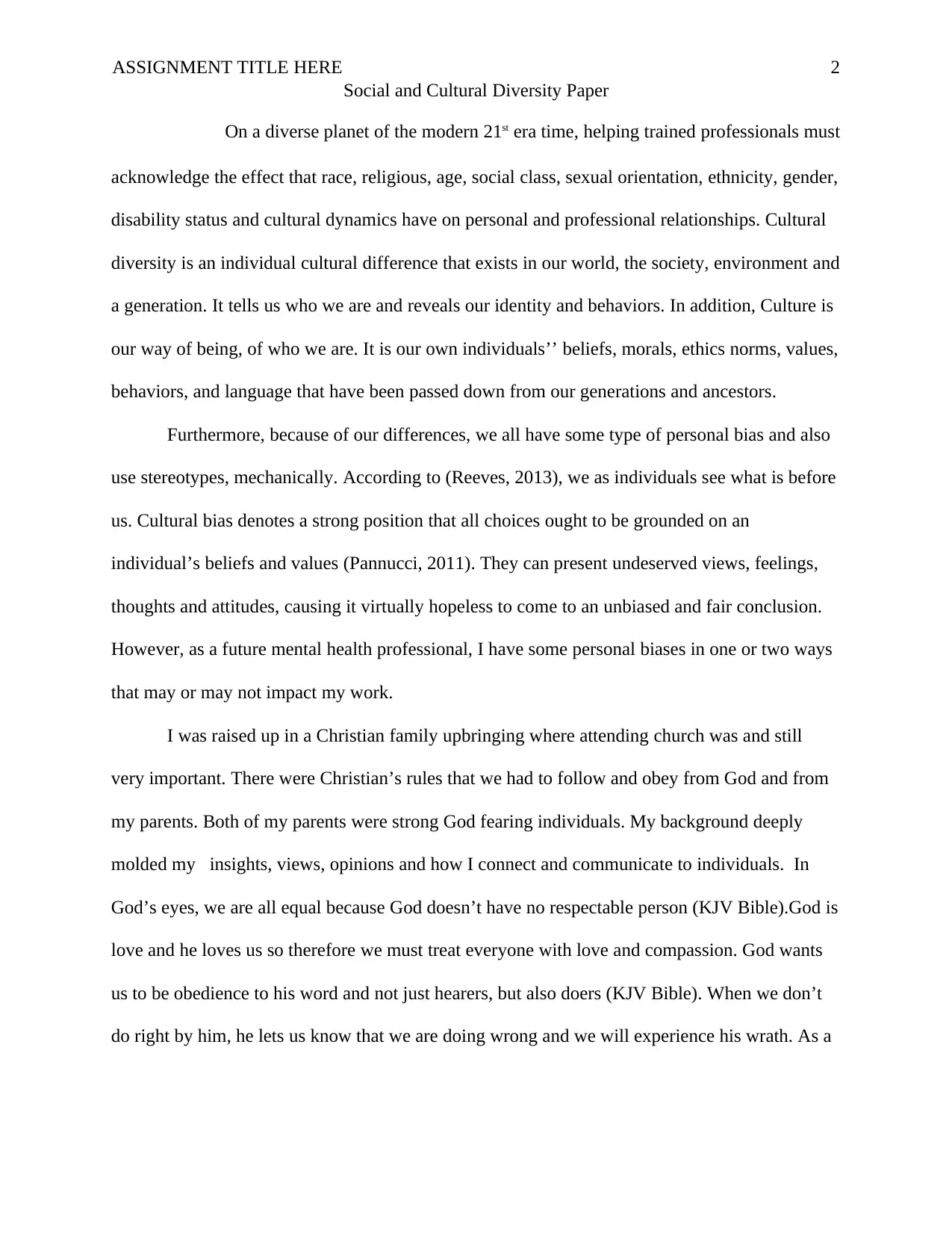
ASSIGNMENT TITLE HERE 2
Social and Cultural Diversity Paper
On a diverse planet of the modern 21st era time, helping trained professionals must
acknowledge the effect that race, religious, age, social class, sexual orientation, ethnicity, gender,
disability status and cultural dynamics have on personal and professional relationships. Cultural
diversity is an individual cultural difference that exists in our world, the society, environment and
a generation. It tells us who we are and reveals our identity and behaviors. In addition, Culture is
our way of being, of who we are. It is our own individuals’’ beliefs, morals, ethics norms, values,
behaviors, and language that have been passed down from our generations and ancestors.
Furthermore, because of our differences, we all have some type of personal bias and also
use stereotypes, mechanically. According to (Reeves, 2013), we as individuals see what is before
us. Cultural bias denotes a strong position that all choices ought to be grounded on an
individual’s beliefs and values (Pannucci, 2011). They can present undeserved views, feelings,
thoughts and attitudes, causing it virtually hopeless to come to an unbiased and fair conclusion.
However, as a future mental health professional, I have some personal biases in one or two ways
that may or may not impact my work.
I was raised up in a Christian family upbringing where attending church was and still
very important. There were Christian’s rules that we had to follow and obey from God and from
my parents. Both of my parents were strong God fearing individuals. My background deeply
molded my insights, views, opinions and how I connect and communicate to individuals. In
God’s eyes, we are all equal because God doesn’t have no respectable person (KJV Bible).God is
love and he loves us so therefore we must treat everyone with love and compassion. God wants
us to be obedience to his word and not just hearers, but also doers (KJV Bible). When we don’t
do right by him, he lets us know that we are doing wrong and we will experience his wrath. As a
Social and Cultural Diversity Paper
On a diverse planet of the modern 21st era time, helping trained professionals must
acknowledge the effect that race, religious, age, social class, sexual orientation, ethnicity, gender,
disability status and cultural dynamics have on personal and professional relationships. Cultural
diversity is an individual cultural difference that exists in our world, the society, environment and
a generation. It tells us who we are and reveals our identity and behaviors. In addition, Culture is
our way of being, of who we are. It is our own individuals’’ beliefs, morals, ethics norms, values,
behaviors, and language that have been passed down from our generations and ancestors.
Furthermore, because of our differences, we all have some type of personal bias and also
use stereotypes, mechanically. According to (Reeves, 2013), we as individuals see what is before
us. Cultural bias denotes a strong position that all choices ought to be grounded on an
individual’s beliefs and values (Pannucci, 2011). They can present undeserved views, feelings,
thoughts and attitudes, causing it virtually hopeless to come to an unbiased and fair conclusion.
However, as a future mental health professional, I have some personal biases in one or two ways
that may or may not impact my work.
I was raised up in a Christian family upbringing where attending church was and still
very important. There were Christian’s rules that we had to follow and obey from God and from
my parents. Both of my parents were strong God fearing individuals. My background deeply
molded my insights, views, opinions and how I connect and communicate to individuals. In
God’s eyes, we are all equal because God doesn’t have no respectable person (KJV Bible).God is
love and he loves us so therefore we must treat everyone with love and compassion. God wants
us to be obedience to his word and not just hearers, but also doers (KJV Bible). When we don’t
do right by him, he lets us know that we are doing wrong and we will experience his wrath. As a
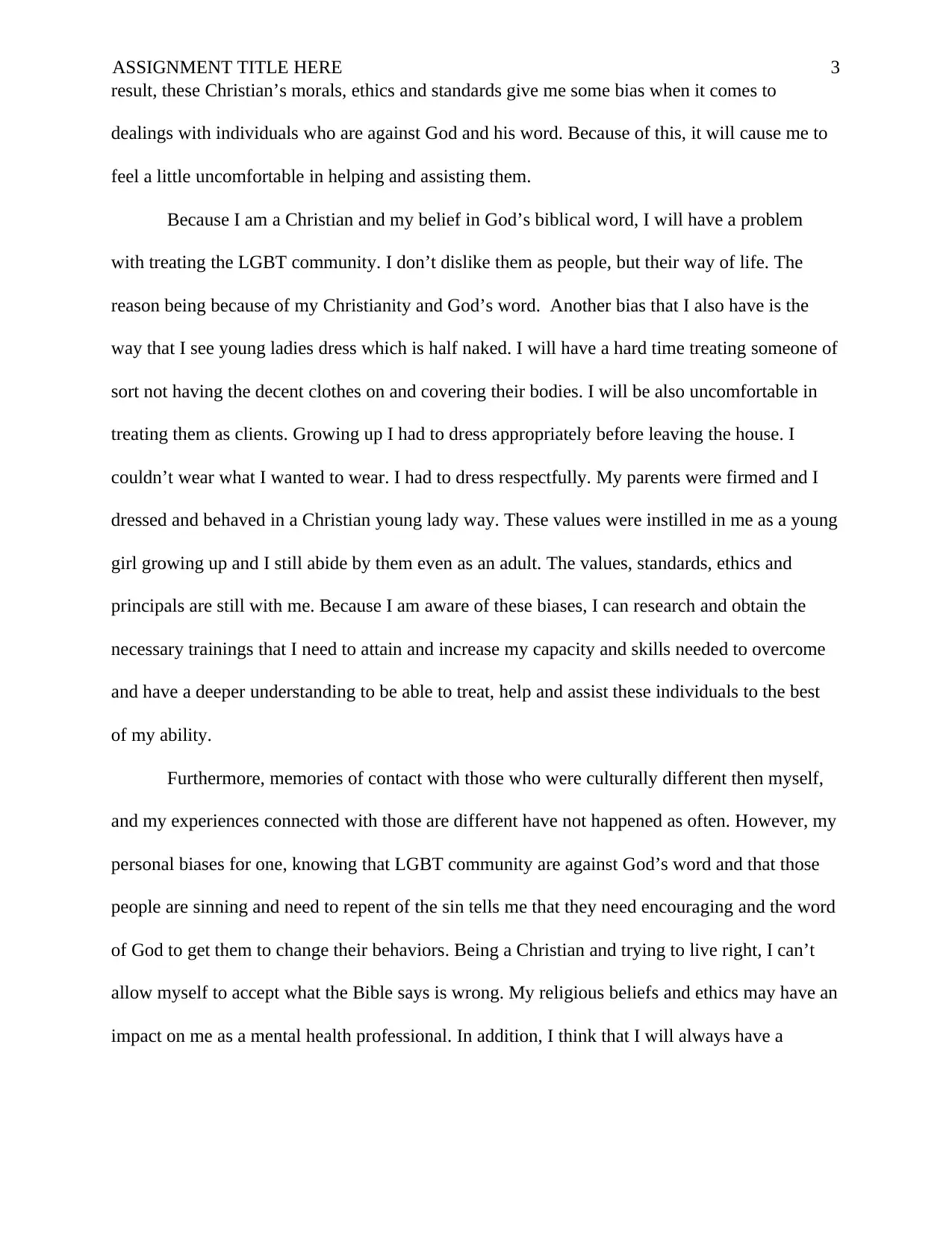
ASSIGNMENT TITLE HERE 3
result, these Christian’s morals, ethics and standards give me some bias when it comes to
dealings with individuals who are against God and his word. Because of this, it will cause me to
feel a little uncomfortable in helping and assisting them.
Because I am a Christian and my belief in God’s biblical word, I will have a problem
with treating the LGBT community. I don’t dislike them as people, but their way of life. The
reason being because of my Christianity and God’s word. Another bias that I also have is the
way that I see young ladies dress which is half naked. I will have a hard time treating someone of
sort not having the decent clothes on and covering their bodies. I will be also uncomfortable in
treating them as clients. Growing up I had to dress appropriately before leaving the house. I
couldn’t wear what I wanted to wear. I had to dress respectfully. My parents were firmed and I
dressed and behaved in a Christian young lady way. These values were instilled in me as a young
girl growing up and I still abide by them even as an adult. The values, standards, ethics and
principals are still with me. Because I am aware of these biases, I can research and obtain the
necessary trainings that I need to attain and increase my capacity and skills needed to overcome
and have a deeper understanding to be able to treat, help and assist these individuals to the best
of my ability.
Furthermore, memories of contact with those who were culturally different then myself,
and my experiences connected with those are different have not happened as often. However, my
personal biases for one, knowing that LGBT community are against God’s word and that those
people are sinning and need to repent of the sin tells me that they need encouraging and the word
of God to get them to change their behaviors. Being a Christian and trying to live right, I can’t
allow myself to accept what the Bible says is wrong. My religious beliefs and ethics may have an
impact on me as a mental health professional. In addition, I think that I will always have a
result, these Christian’s morals, ethics and standards give me some bias when it comes to
dealings with individuals who are against God and his word. Because of this, it will cause me to
feel a little uncomfortable in helping and assisting them.
Because I am a Christian and my belief in God’s biblical word, I will have a problem
with treating the LGBT community. I don’t dislike them as people, but their way of life. The
reason being because of my Christianity and God’s word. Another bias that I also have is the
way that I see young ladies dress which is half naked. I will have a hard time treating someone of
sort not having the decent clothes on and covering their bodies. I will be also uncomfortable in
treating them as clients. Growing up I had to dress appropriately before leaving the house. I
couldn’t wear what I wanted to wear. I had to dress respectfully. My parents were firmed and I
dressed and behaved in a Christian young lady way. These values were instilled in me as a young
girl growing up and I still abide by them even as an adult. The values, standards, ethics and
principals are still with me. Because I am aware of these biases, I can research and obtain the
necessary trainings that I need to attain and increase my capacity and skills needed to overcome
and have a deeper understanding to be able to treat, help and assist these individuals to the best
of my ability.
Furthermore, memories of contact with those who were culturally different then myself,
and my experiences connected with those are different have not happened as often. However, my
personal biases for one, knowing that LGBT community are against God’s word and that those
people are sinning and need to repent of the sin tells me that they need encouraging and the word
of God to get them to change their behaviors. Being a Christian and trying to live right, I can’t
allow myself to accept what the Bible says is wrong. My religious beliefs and ethics may have an
impact on me as a mental health professional. In addition, I think that I will always have a
⊘ This is a preview!⊘
Do you want full access?
Subscribe today to unlock all pages.

Trusted by 1+ million students worldwide
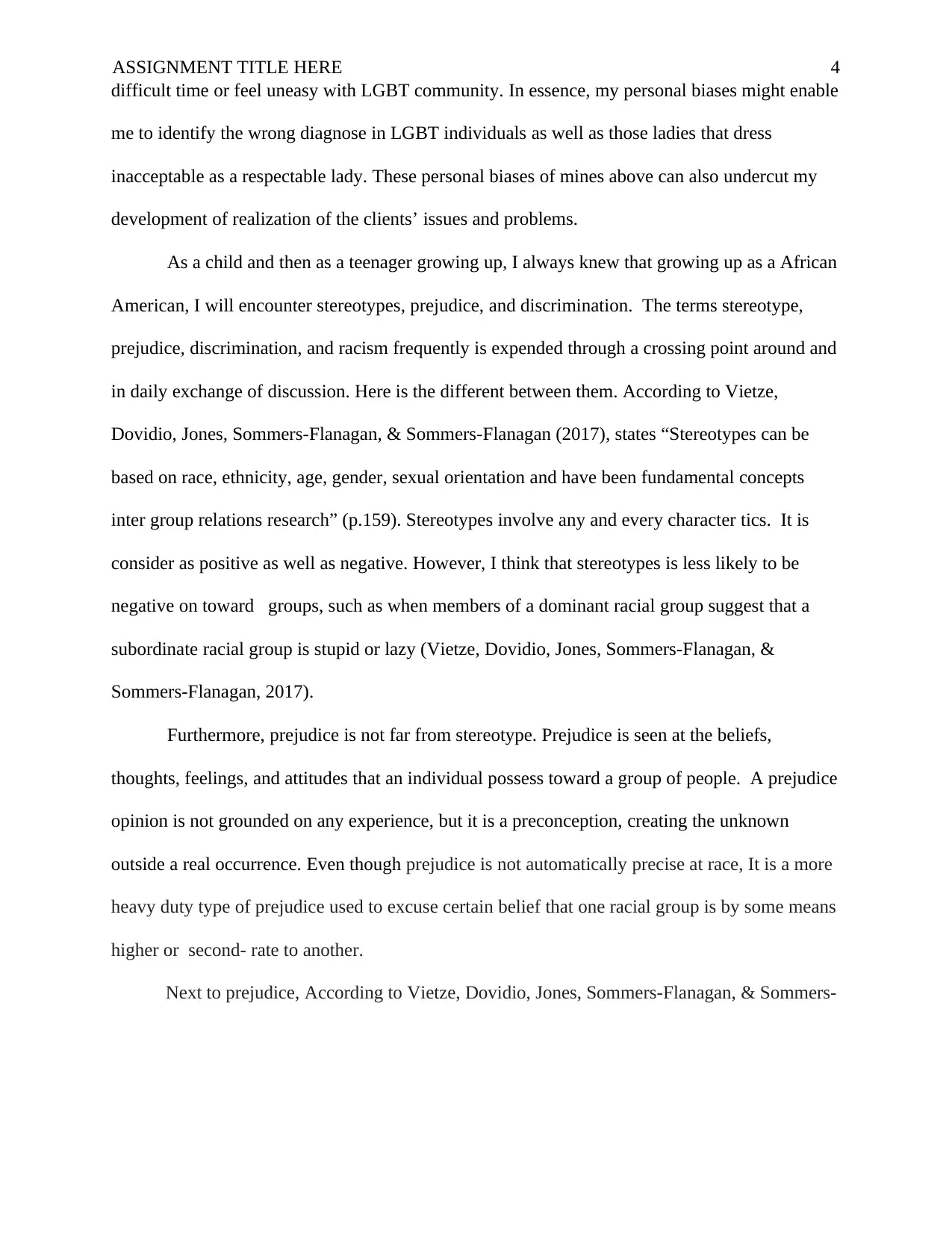
ASSIGNMENT TITLE HERE 4
difficult time or feel uneasy with LGBT community. In essence, my personal biases might enable
me to identify the wrong diagnose in LGBT individuals as well as those ladies that dress
inacceptable as a respectable lady. These personal biases of mines above can also undercut my
development of realization of the clients’ issues and problems.
As a child and then as a teenager growing up, I always knew that growing up as a African
American, I will encounter stereotypes, prejudice, and discrimination. The terms stereotype,
prejudice, discrimination, and racism frequently is expended through a crossing point around and
in daily exchange of discussion. Here is the different between them. According to Vietze,
Dovidio, Jones, Sommers-Flanagan, & Sommers-Flanagan (2017), states “Stereotypes can be
based on race, ethnicity, age, gender, sexual orientation and have been fundamental concepts
inter group relations research” (p.159). Stereotypes involve any and every character tics. It is
consider as positive as well as negative. However, I think that stereotypes is less likely to be
negative on toward groups, such as when members of a dominant racial group suggest that a
subordinate racial group is stupid or lazy (Vietze, Dovidio, Jones, Sommers-Flanagan, &
Sommers-Flanagan, 2017).
Furthermore, prejudice is not far from stereotype. Prejudice is seen at the beliefs,
thoughts, feelings, and attitudes that an individual possess toward a group of people. A prejudice
opinion is not grounded on any experience, but it is a preconception, creating the unknown
outside a real occurrence. Even though prejudice is not automatically precise at race, It is a more
heavy duty type of prejudice used to excuse certain belief that one racial group is by some means
higher or second- rate to another.
Next to prejudice, According to Vietze, Dovidio, Jones, Sommers-Flanagan, & Sommers-
difficult time or feel uneasy with LGBT community. In essence, my personal biases might enable
me to identify the wrong diagnose in LGBT individuals as well as those ladies that dress
inacceptable as a respectable lady. These personal biases of mines above can also undercut my
development of realization of the clients’ issues and problems.
As a child and then as a teenager growing up, I always knew that growing up as a African
American, I will encounter stereotypes, prejudice, and discrimination. The terms stereotype,
prejudice, discrimination, and racism frequently is expended through a crossing point around and
in daily exchange of discussion. Here is the different between them. According to Vietze,
Dovidio, Jones, Sommers-Flanagan, & Sommers-Flanagan (2017), states “Stereotypes can be
based on race, ethnicity, age, gender, sexual orientation and have been fundamental concepts
inter group relations research” (p.159). Stereotypes involve any and every character tics. It is
consider as positive as well as negative. However, I think that stereotypes is less likely to be
negative on toward groups, such as when members of a dominant racial group suggest that a
subordinate racial group is stupid or lazy (Vietze, Dovidio, Jones, Sommers-Flanagan, &
Sommers-Flanagan, 2017).
Furthermore, prejudice is not far from stereotype. Prejudice is seen at the beliefs,
thoughts, feelings, and attitudes that an individual possess toward a group of people. A prejudice
opinion is not grounded on any experience, but it is a preconception, creating the unknown
outside a real occurrence. Even though prejudice is not automatically precise at race, It is a more
heavy duty type of prejudice used to excuse certain belief that one racial group is by some means
higher or second- rate to another.
Next to prejudice, According to Vietze, Dovidio, Jones, Sommers-Flanagan, & Sommers-
Paraphrase This Document
Need a fresh take? Get an instant paraphrase of this document with our AI Paraphraser
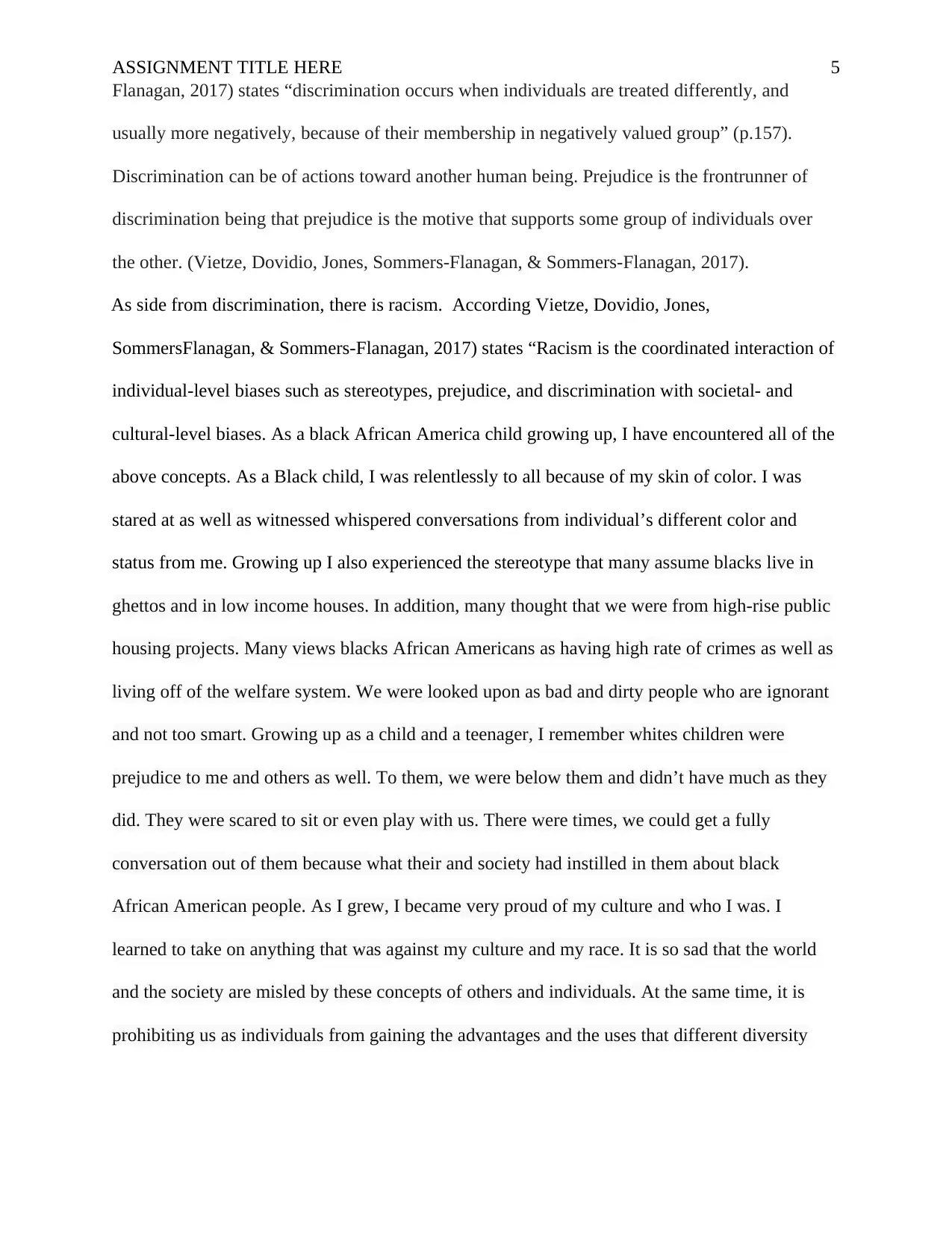
ASSIGNMENT TITLE HERE 5
Flanagan, 2017) states “discrimination occurs when individuals are treated differently, and
usually more negatively, because of their membership in negatively valued group” (p.157).
Discrimination can be of actions toward another human being. Prejudice is the frontrunner of
discrimination being that prejudice is the motive that supports some group of individuals over
the other. (Vietze, Dovidio, Jones, Sommers-Flanagan, & Sommers-Flanagan, 2017).
As side from discrimination, there is racism. According Vietze, Dovidio, Jones,
SommersFlanagan, & Sommers-Flanagan, 2017) states “Racism is the coordinated interaction of
individual-level biases such as stereotypes, prejudice, and discrimination with societal- and
cultural-level biases. As a black African America child growing up, I have encountered all of the
above concepts. As a Black child, I was relentlessly to all because of my skin of color. I was
stared at as well as witnessed whispered conversations from individual’s different color and
status from me. Growing up I also experienced the stereotype that many assume blacks live in
ghettos and in low income houses. In addition, many thought that we were from high-rise public
housing projects. Many views blacks African Americans as having high rate of crimes as well as
living off of the welfare system. We were looked upon as bad and dirty people who are ignorant
and not too smart. Growing up as a child and a teenager, I remember whites children were
prejudice to me and others as well. To them, we were below them and didn’t have much as they
did. They were scared to sit or even play with us. There were times, we could get a fully
conversation out of them because what their and society had instilled in them about black
African American people. As I grew, I became very proud of my culture and who I was. I
learned to take on anything that was against my culture and my race. It is so sad that the world
and the society are misled by these concepts of others and individuals. At the same time, it is
prohibiting us as individuals from gaining the advantages and the uses that different diversity
Flanagan, 2017) states “discrimination occurs when individuals are treated differently, and
usually more negatively, because of their membership in negatively valued group” (p.157).
Discrimination can be of actions toward another human being. Prejudice is the frontrunner of
discrimination being that prejudice is the motive that supports some group of individuals over
the other. (Vietze, Dovidio, Jones, Sommers-Flanagan, & Sommers-Flanagan, 2017).
As side from discrimination, there is racism. According Vietze, Dovidio, Jones,
SommersFlanagan, & Sommers-Flanagan, 2017) states “Racism is the coordinated interaction of
individual-level biases such as stereotypes, prejudice, and discrimination with societal- and
cultural-level biases. As a black African America child growing up, I have encountered all of the
above concepts. As a Black child, I was relentlessly to all because of my skin of color. I was
stared at as well as witnessed whispered conversations from individual’s different color and
status from me. Growing up I also experienced the stereotype that many assume blacks live in
ghettos and in low income houses. In addition, many thought that we were from high-rise public
housing projects. Many views blacks African Americans as having high rate of crimes as well as
living off of the welfare system. We were looked upon as bad and dirty people who are ignorant
and not too smart. Growing up as a child and a teenager, I remember whites children were
prejudice to me and others as well. To them, we were below them and didn’t have much as they
did. They were scared to sit or even play with us. There were times, we could get a fully
conversation out of them because what their and society had instilled in them about black
African American people. As I grew, I became very proud of my culture and who I was. I
learned to take on anything that was against my culture and my race. It is so sad that the world
and the society are misled by these concepts of others and individuals. At the same time, it is
prohibiting us as individuals from gaining the advantages and the uses that different diversity
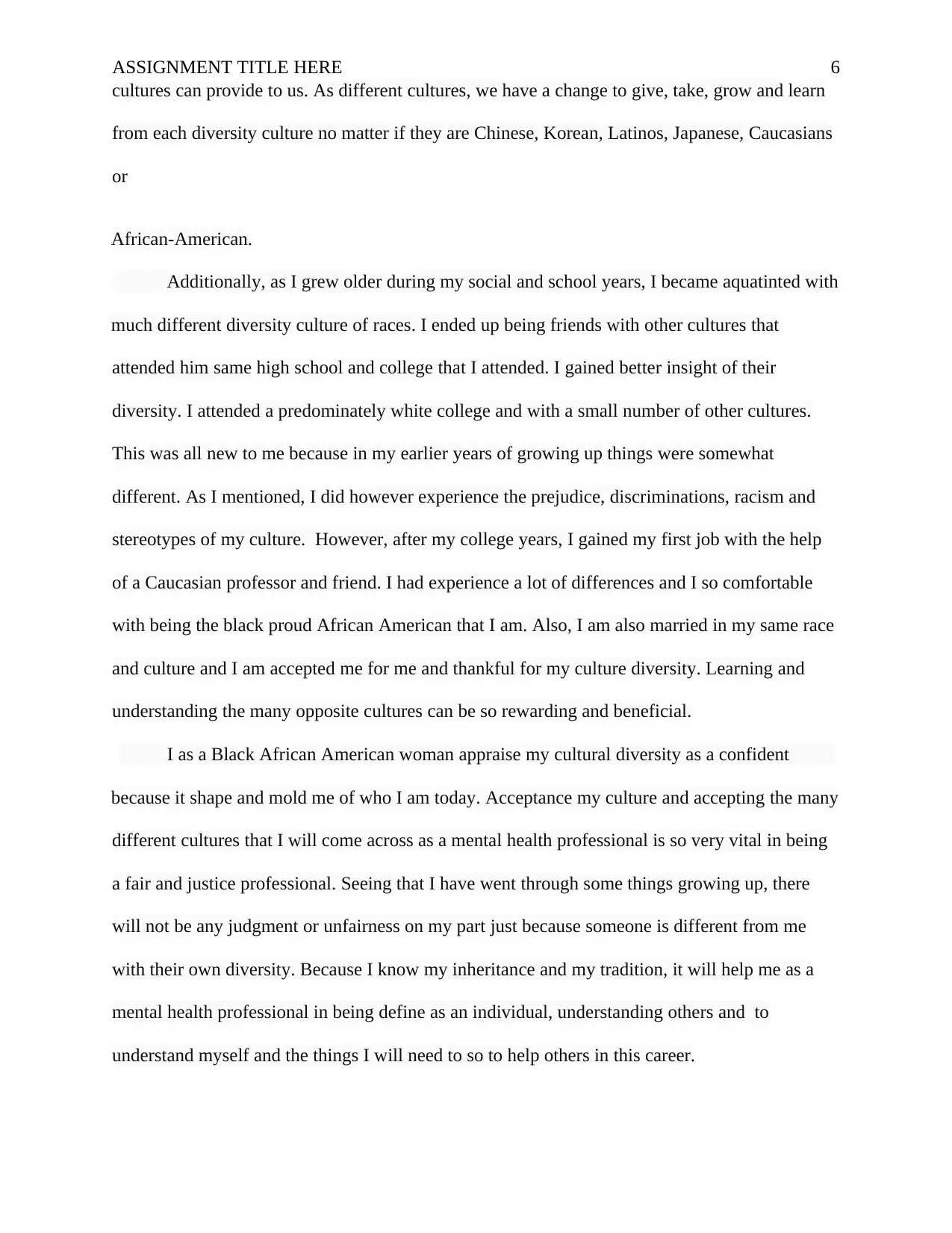
ASSIGNMENT TITLE HERE 6
cultures can provide to us. As different cultures, we have a change to give, take, grow and learn
from each diversity culture no matter if they are Chinese, Korean, Latinos, Japanese, Caucasians
or
African-American.
Additionally, as I grew older during my social and school years, I became aquatinted with
much different diversity culture of races. I ended up being friends with other cultures that
attended him same high school and college that I attended. I gained better insight of their
diversity. I attended a predominately white college and with a small number of other cultures.
This was all new to me because in my earlier years of growing up things were somewhat
different. As I mentioned, I did however experience the prejudice, discriminations, racism and
stereotypes of my culture. However, after my college years, I gained my first job with the help
of a Caucasian professor and friend. I had experience a lot of differences and I so comfortable
with being the black proud African American that I am. Also, I am also married in my same race
and culture and I am accepted me for me and thankful for my culture diversity. Learning and
understanding the many opposite cultures can be so rewarding and beneficial.
I as a Black African American woman appraise my cultural diversity as a confident
because it shape and mold me of who I am today. Acceptance my culture and accepting the many
different cultures that I will come across as a mental health professional is so very vital in being
a fair and justice professional. Seeing that I have went through some things growing up, there
will not be any judgment or unfairness on my part just because someone is different from me
with their own diversity. Because I know my inheritance and my tradition, it will help me as a
mental health professional in being define as an individual, understanding others and to
understand myself and the things I will need to so to help others in this career.
cultures can provide to us. As different cultures, we have a change to give, take, grow and learn
from each diversity culture no matter if they are Chinese, Korean, Latinos, Japanese, Caucasians
or
African-American.
Additionally, as I grew older during my social and school years, I became aquatinted with
much different diversity culture of races. I ended up being friends with other cultures that
attended him same high school and college that I attended. I gained better insight of their
diversity. I attended a predominately white college and with a small number of other cultures.
This was all new to me because in my earlier years of growing up things were somewhat
different. As I mentioned, I did however experience the prejudice, discriminations, racism and
stereotypes of my culture. However, after my college years, I gained my first job with the help
of a Caucasian professor and friend. I had experience a lot of differences and I so comfortable
with being the black proud African American that I am. Also, I am also married in my same race
and culture and I am accepted me for me and thankful for my culture diversity. Learning and
understanding the many opposite cultures can be so rewarding and beneficial.
I as a Black African American woman appraise my cultural diversity as a confident
because it shape and mold me of who I am today. Acceptance my culture and accepting the many
different cultures that I will come across as a mental health professional is so very vital in being
a fair and justice professional. Seeing that I have went through some things growing up, there
will not be any judgment or unfairness on my part just because someone is different from me
with their own diversity. Because I know my inheritance and my tradition, it will help me as a
mental health professional in being define as an individual, understanding others and to
understand myself and the things I will need to so to help others in this career.
⊘ This is a preview!⊘
Do you want full access?
Subscribe today to unlock all pages.

Trusted by 1+ million students worldwide
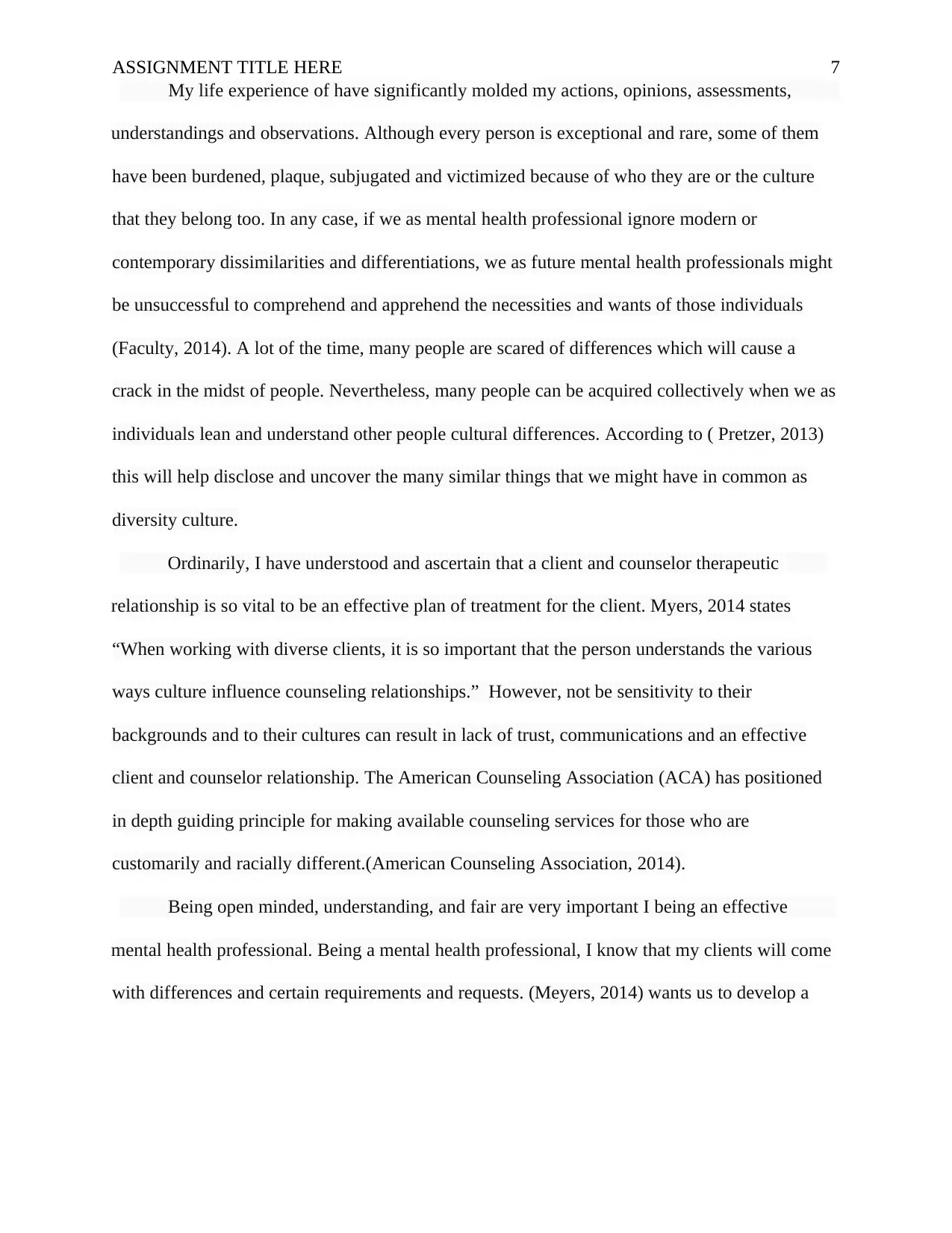
ASSIGNMENT TITLE HERE 7
My life experience of have significantly molded my actions, opinions, assessments,
understandings and observations. Although every person is exceptional and rare, some of them
have been burdened, plaque, subjugated and victimized because of who they are or the culture
that they belong too. In any case, if we as mental health professional ignore modern or
contemporary dissimilarities and differentiations, we as future mental health professionals might
be unsuccessful to comprehend and apprehend the necessities and wants of those individuals
(Faculty, 2014). A lot of the time, many people are scared of differences which will cause a
crack in the midst of people. Nevertheless, many people can be acquired collectively when we as
individuals lean and understand other people cultural differences. According to ( Pretzer, 2013)
this will help disclose and uncover the many similar things that we might have in common as
diversity culture.
Ordinarily, I have understood and ascertain that a client and counselor therapeutic
relationship is so vital to be an effective plan of treatment for the client. Myers, 2014 states
“When working with diverse clients, it is so important that the person understands the various
ways culture influence counseling relationships.” However, not be sensitivity to their
backgrounds and to their cultures can result in lack of trust, communications and an effective
client and counselor relationship. The American Counseling Association (ACA) has positioned
in depth guiding principle for making available counseling services for those who are
customarily and racially different.(American Counseling Association, 2014).
Being open minded, understanding, and fair are very important I being an effective
mental health professional. Being a mental health professional, I know that my clients will come
with differences and certain requirements and requests. (Meyers, 2014) wants us to develop a
My life experience of have significantly molded my actions, opinions, assessments,
understandings and observations. Although every person is exceptional and rare, some of them
have been burdened, plaque, subjugated and victimized because of who they are or the culture
that they belong too. In any case, if we as mental health professional ignore modern or
contemporary dissimilarities and differentiations, we as future mental health professionals might
be unsuccessful to comprehend and apprehend the necessities and wants of those individuals
(Faculty, 2014). A lot of the time, many people are scared of differences which will cause a
crack in the midst of people. Nevertheless, many people can be acquired collectively when we as
individuals lean and understand other people cultural differences. According to ( Pretzer, 2013)
this will help disclose and uncover the many similar things that we might have in common as
diversity culture.
Ordinarily, I have understood and ascertain that a client and counselor therapeutic
relationship is so vital to be an effective plan of treatment for the client. Myers, 2014 states
“When working with diverse clients, it is so important that the person understands the various
ways culture influence counseling relationships.” However, not be sensitivity to their
backgrounds and to their cultures can result in lack of trust, communications and an effective
client and counselor relationship. The American Counseling Association (ACA) has positioned
in depth guiding principle for making available counseling services for those who are
customarily and racially different.(American Counseling Association, 2014).
Being open minded, understanding, and fair are very important I being an effective
mental health professional. Being a mental health professional, I know that my clients will come
with differences and certain requirements and requests. (Meyers, 2014) wants us to develop a
Paraphrase This Document
Need a fresh take? Get an instant paraphrase of this document with our AI Paraphraser
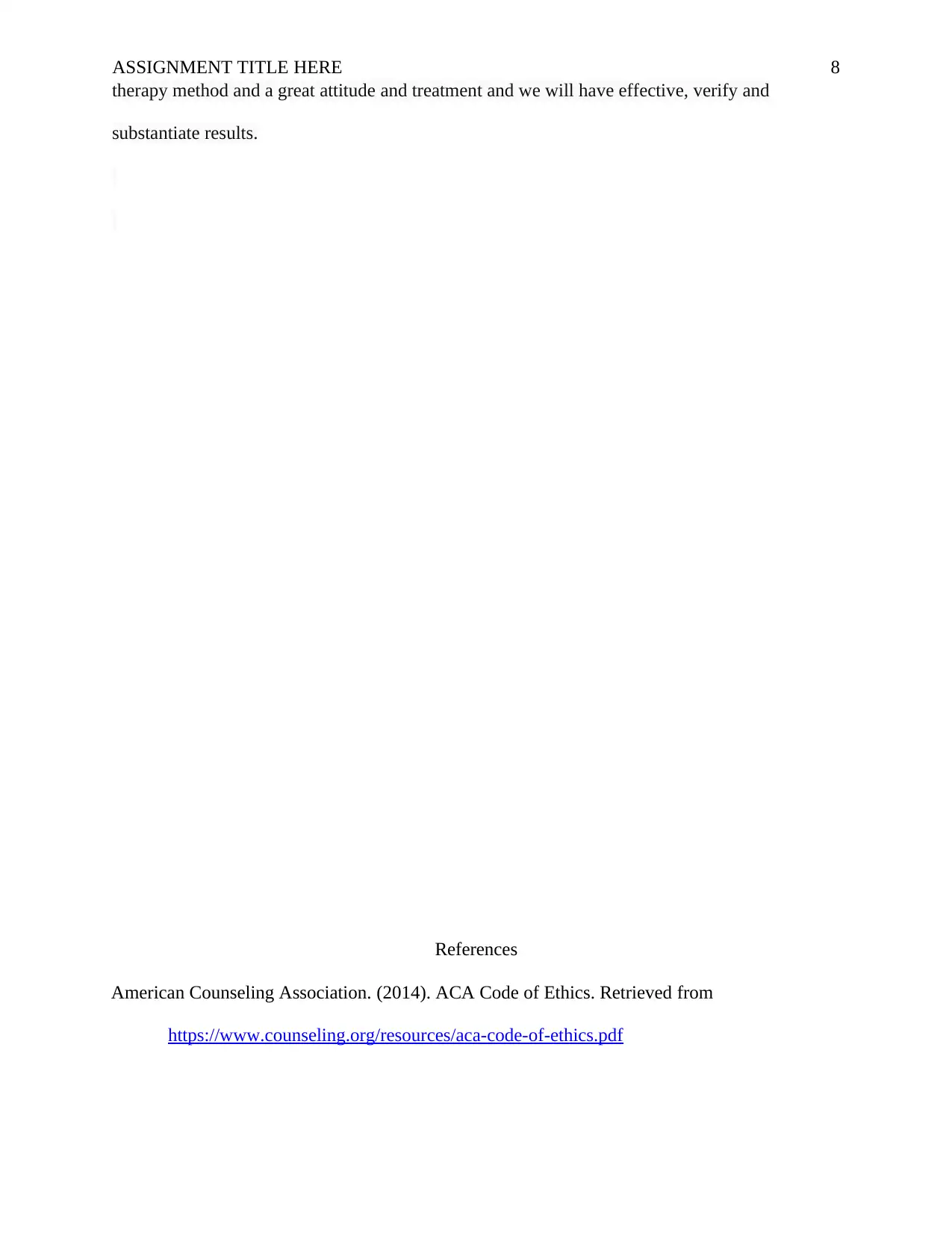
ASSIGNMENT TITLE HERE 8
therapy method and a great attitude and treatment and we will have effective, verify and
substantiate results.
References
American Counseling Association. (2014). ACA Code of Ethics. Retrieved from
https://www.counseling.org/resources/aca-code-of-ethics.pdf
therapy method and a great attitude and treatment and we will have effective, verify and
substantiate results.
References
American Counseling Association. (2014). ACA Code of Ethics. Retrieved from
https://www.counseling.org/resources/aca-code-of-ethics.pdf
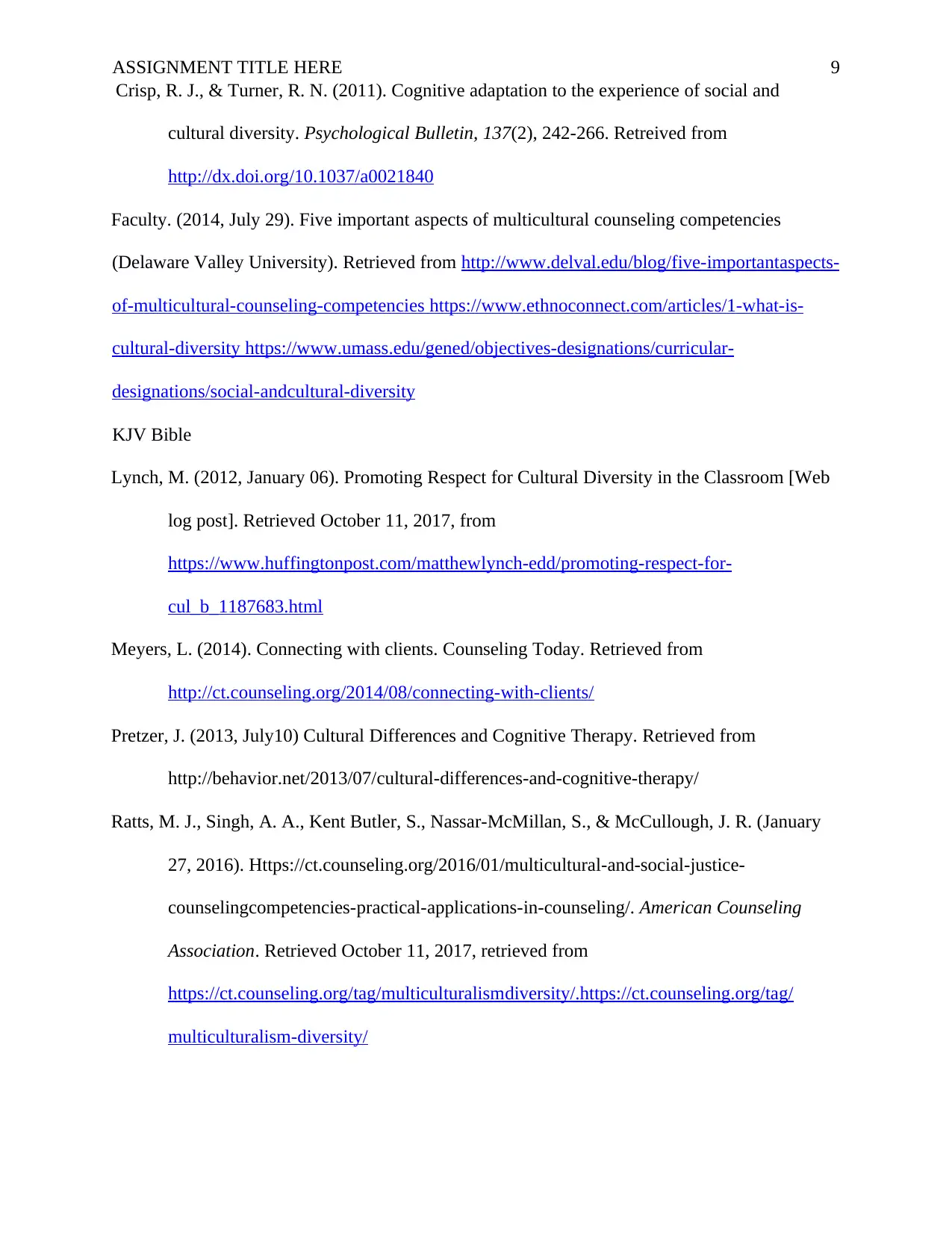
ASSIGNMENT TITLE HERE 9
Crisp, R. J., & Turner, R. N. (2011). Cognitive adaptation to the experience of social and
cultural diversity. Psychological Bulletin, 137(2), 242-266. Retreived from
http://dx.doi.org/10.1037/a0021840
Faculty. (2014, July 29). Five important aspects of multicultural counseling competencies
(Delaware Valley University). Retrieved from http://www.delval.edu/blog/five-importantaspects-
of-multicultural-counseling-competencies https://www.ethnoconnect.com/articles/1-what-is-
cultural-diversity https://www.umass.edu/gened/objectives-designations/curricular-
designations/social-andcultural-diversity
KJV Bible
Lynch, M. (2012, January 06). Promoting Respect for Cultural Diversity in the Classroom [Web
log post]. Retrieved October 11, 2017, from
https://www.huffingtonpost.com/matthewlynch-edd/promoting-respect-for-
cul_b_1187683.html
Meyers, L. (2014). Connecting with clients. Counseling Today. Retrieved from
http://ct.counseling.org/2014/08/connecting-with-clients/
Pretzer, J. (2013, July10) Cultural Differences and Cognitive Therapy. Retrieved from
http://behavior.net/2013/07/cultural-differences-and-cognitive-therapy/
Ratts, M. J., Singh, A. A., Kent Butler, S., Nassar-McMillan, S., & McCullough, J. R. (January
27, 2016). Https://ct.counseling.org/2016/01/multicultural-and-social-justice-
counselingcompetencies-practical-applications-in-counseling/. American Counseling
Association. Retrieved October 11, 2017, retrieved from
https://ct.counseling.org/tag/multiculturalismdiversity/.https://ct.counseling.org/tag/
multiculturalism-diversity/
Crisp, R. J., & Turner, R. N. (2011). Cognitive adaptation to the experience of social and
cultural diversity. Psychological Bulletin, 137(2), 242-266. Retreived from
http://dx.doi.org/10.1037/a0021840
Faculty. (2014, July 29). Five important aspects of multicultural counseling competencies
(Delaware Valley University). Retrieved from http://www.delval.edu/blog/five-importantaspects-
of-multicultural-counseling-competencies https://www.ethnoconnect.com/articles/1-what-is-
cultural-diversity https://www.umass.edu/gened/objectives-designations/curricular-
designations/social-andcultural-diversity
KJV Bible
Lynch, M. (2012, January 06). Promoting Respect for Cultural Diversity in the Classroom [Web
log post]. Retrieved October 11, 2017, from
https://www.huffingtonpost.com/matthewlynch-edd/promoting-respect-for-
cul_b_1187683.html
Meyers, L. (2014). Connecting with clients. Counseling Today. Retrieved from
http://ct.counseling.org/2014/08/connecting-with-clients/
Pretzer, J. (2013, July10) Cultural Differences and Cognitive Therapy. Retrieved from
http://behavior.net/2013/07/cultural-differences-and-cognitive-therapy/
Ratts, M. J., Singh, A. A., Kent Butler, S., Nassar-McMillan, S., & McCullough, J. R. (January
27, 2016). Https://ct.counseling.org/2016/01/multicultural-and-social-justice-
counselingcompetencies-practical-applications-in-counseling/. American Counseling
Association. Retrieved October 11, 2017, retrieved from
https://ct.counseling.org/tag/multiculturalismdiversity/.https://ct.counseling.org/tag/
multiculturalism-diversity/
⊘ This is a preview!⊘
Do you want full access?
Subscribe today to unlock all pages.

Trusted by 1+ million students worldwide
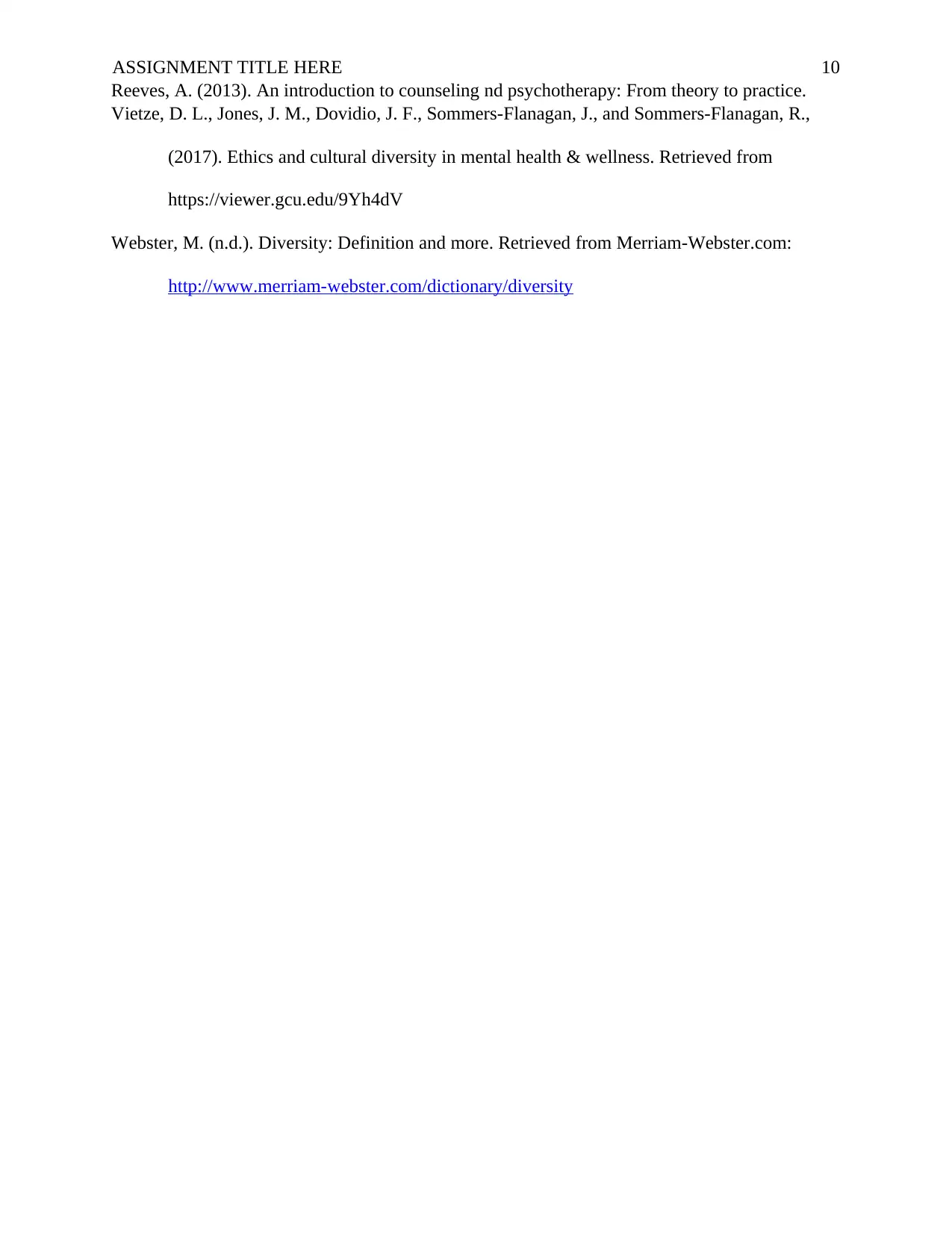
ASSIGNMENT TITLE HERE 10
Reeves, A. (2013). An introduction to counseling nd psychotherapy: From theory to practice.
Vietze, D. L., Jones, J. M., Dovidio, J. F., Sommers-Flanagan, J., and Sommers-Flanagan, R.,
(2017). Ethics and cultural diversity in mental health & wellness. Retrieved from
https://viewer.gcu.edu/9Yh4dV
Webster, M. (n.d.). Diversity: Definition and more. Retrieved from Merriam-Webster.com:
http://www.merriam-webster.com/dictionary/diversity
Reeves, A. (2013). An introduction to counseling nd psychotherapy: From theory to practice.
Vietze, D. L., Jones, J. M., Dovidio, J. F., Sommers-Flanagan, J., and Sommers-Flanagan, R.,
(2017). Ethics and cultural diversity in mental health & wellness. Retrieved from
https://viewer.gcu.edu/9Yh4dV
Webster, M. (n.d.). Diversity: Definition and more. Retrieved from Merriam-Webster.com:
http://www.merriam-webster.com/dictionary/diversity
1 out of 10
Related Documents
Your All-in-One AI-Powered Toolkit for Academic Success.
+13062052269
info@desklib.com
Available 24*7 on WhatsApp / Email
![[object Object]](/_next/static/media/star-bottom.7253800d.svg)
Unlock your academic potential
Copyright © 2020–2025 A2Z Services. All Rights Reserved. Developed and managed by ZUCOL.





